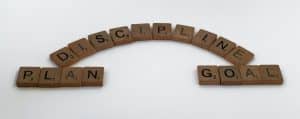How To Stay Consistent With Your Workout Routine
 It takes a consistent effort to be successful regardless of your fitness goal. If you workout intensely one day for two and a half hours and do nothing for several weeks, you don’t make much gain. You need between 150-300 minutes of moderate exercise each week or 75-150 minutes of intense exercise each week. The good news is that you can do it in two, three, four, five, six, or seven days.
It takes a consistent effort to be successful regardless of your fitness goal. If you workout intensely one day for two and a half hours and do nothing for several weeks, you don’t make much gain. You need between 150-300 minutes of moderate exercise each week or 75-150 minutes of intense exercise each week. The good news is that you can do it in two, three, four, five, six, or seven days.
It’s easier to stay consistent.
You’ll reap more benefits if you schedule it at the same time daily. Create a workout appointment on your calendar at the same time daily. That helps turn it into a habit. Habits are difficult to break. Have you ever headed out to shop on your day off work and suddenly realized you were on the route you take to work and not to the mall? It’s a habit that makes you do that. You don’t have to do all your exercise in the gym. You can swim, walk, take a dance class, or play a sport. Just move!
Do it with a friend.
When you workout with someone else, whether a workout buddy or personal trainer, they hold you accountable for showing up and exercising. If you exercise with a friend, it can make exercising more social and more fun. If you choose a trainer, you’ll probably work harder and get better results because the trainer will push you. Trainers create programs specifically designed for your fitness level, goals, and special needs.
If life gets in the way of your scheduled time, break your workout into shorter sessions.
Life can be hectic. Your mornings may be the best time to exercise normally, but now your child has a morning band practice. Your morning is not crowded because someone has to drive them. Maybe working out after work is perfect until that big press to finish a presentation. If you have to miss a session, be flexible. Do 10 minutes in the morning, walk at lunch, and do another ten-minute session at the end of the day. You can break your workout into several sessions.
- Remind yourself to exercise. If you don’t have a problem exercising during the week but find it hard to remember on the weekend, set a workout alarm. You can use your phone or your alarm clock if necessary.
- Have your gym clothes packed and ready to go the night before. You can even put your gym bag in the car so you don’t forget it. If you go to the gym first thing in the morning, lay out your gym clothes and have your street clothes and toiletries packed.
- Don’t try to do everything at once. If you overdo it the first few days, you’ll probably hurt too much to continue immediately. Take it easy during the first few sessions and focus on form rather than intensity and repetitions.
- Track your progress. When you write down your workout and track your progress, it’s motivating. On days when you struggle, you can go back and see where you started. It also turns exercise into a game where you challenge yourself.
For more information, contact us today at Iron Fit San Antonio



















